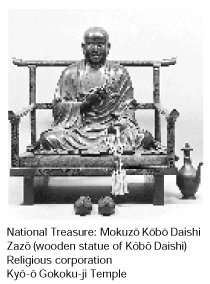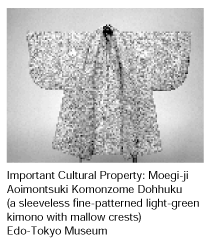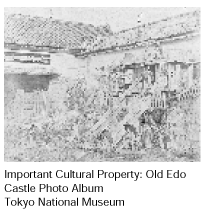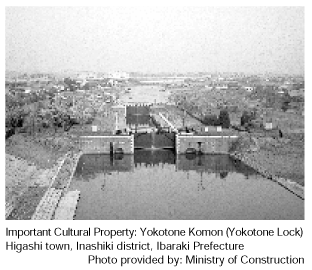| Home > Policy > White Paper, Notice, Announcement > White Paper > Japanese Government Policies in Education, Science, Sports and Culture 2000 > Part 2 Chapter 8 Section 6 2 | ||
Regarding the designation of fine and applied artworks, in FY2000, the "Meigetsuki (Record of the Radiant Moon)," a diary written by aristocrat Fujiwara no Teika which includes detailed facts about court society at the end of the Heian period/beginning of the Kamakura period, and the "Mokuzo Kobo Daishi Zazo" (wooden statue of Kobo Daishi), the origin of faith for Kobo Daishi, the founder of the Shingon sect of Buddhism which spread throughout Japan after the Middle Ages, were designated as national treasures. In addition, 45 items were designated as important cultural properties, including the painting "Jo-no-mai" by UEMURA Shoen, the first work created by a woman to be designated; the "Moegi-ji Aoimontsuki Komonzome Dohbuku" (a sleeveless fine-patterned light-green kimono with mallow crests) which IMAMURA Denshiro Masanaga received as a reward for his daring military exploits during the Osaka Summer Battle in 1615; the "Objects Excavated from the Amamiyayama Tumulus, Osaka" which are extremely valuable objects in light of the changes in articles buried with the dead at the beginning of the Kofun period (300-710 AD); and the "Old Edo Castle Photo Album" which provides a record of Edo Castle during the early Meiji period, using wet-plate photography, which was the newest technology of the time.
The designation of buildings as important cultural properties has primarily focused on modern buildings (those constructed since the Meiji period). Modern structures such as Yokotone Lock (Higashi town, Inashiki district, Ibaraki Prefecture) and Sendohira Lock (Tatsuta village, Ama district, Aichi Prefecture) were designated as important cultural properties in May 2000.
In addition, of the buildings which have already been designated as important cultural properties, the most superior or culturally significant are selected to become National Treasures.
Cultural properties are an extremely precious asset for the entire nation, which cannot be repaired once their value is damaged.
The management and repair of nationally designated tangible cultural properties is, in principle, undertaken by the owners, but if the owners are not managing the property appropriately, the Director-General of the Agency for Cultural Affairs will designate a managing body, such as the local government of the region, in order that the property will be managed and repaired properly.
In addition, when fine and applied artworks and buildings that have been nationally designated as tangible cultural properties come in need of repair, government grants are provided to the owners so that they can conduct systematic repairs, and facilities and equipment are established to ensure their preservation and safety.
Furthermore, in order to protect cultural properties from disasters such as fires, it is necessary for the owners of cultural properties, in collaboration with national and local governments, to thoroughly address the appropriate management of cultural properties. In light of the damage to cultural properties caused by the Great Hanshin-Awaji Earthquake in January 1995, specific earthquake-proof diagnostic guidelines and guidance for earthquake-proof diagnostics easy for owners to implement are being formulated with a view to ensuring the stability of buildings designated as cultural properties.
Regarding tax-related support measures for cultural properties which have been designated or otherwise recognized, important cultural properties which have been transferred to national or local governments are exempt from income tax, and buildings which have been designated as important cultural properties have been made exempt from property tax.
Furthermore, regarding the imposition of inheritance tax and gift tax, the appraised value of certain important cultural properties is reduced by a certain amount in consideration of the legal constraints placed on said structure.
In order to expand opportunities for people to appreciate important cultural properties, the national government bears a portion of the cost for museums and other cultural facilities to hold exhibitions of fine and applied arts.
Furthermore, because it is necessary to conserve historic buildings while making the best possible use of them, the Agency for Cultural Affairs outlined its "Basic Policy on the Utilization of Important Cultural Properties (Buildings)" in December 1996, and is working to disseminate the ideas contained therein. In March 1999, the Agency created a set of guidelines compiling issues such as considerations to be made in formulating a preservation and utilization plan for holders of cultural properties.




| Back to Top | MEXT HOME |